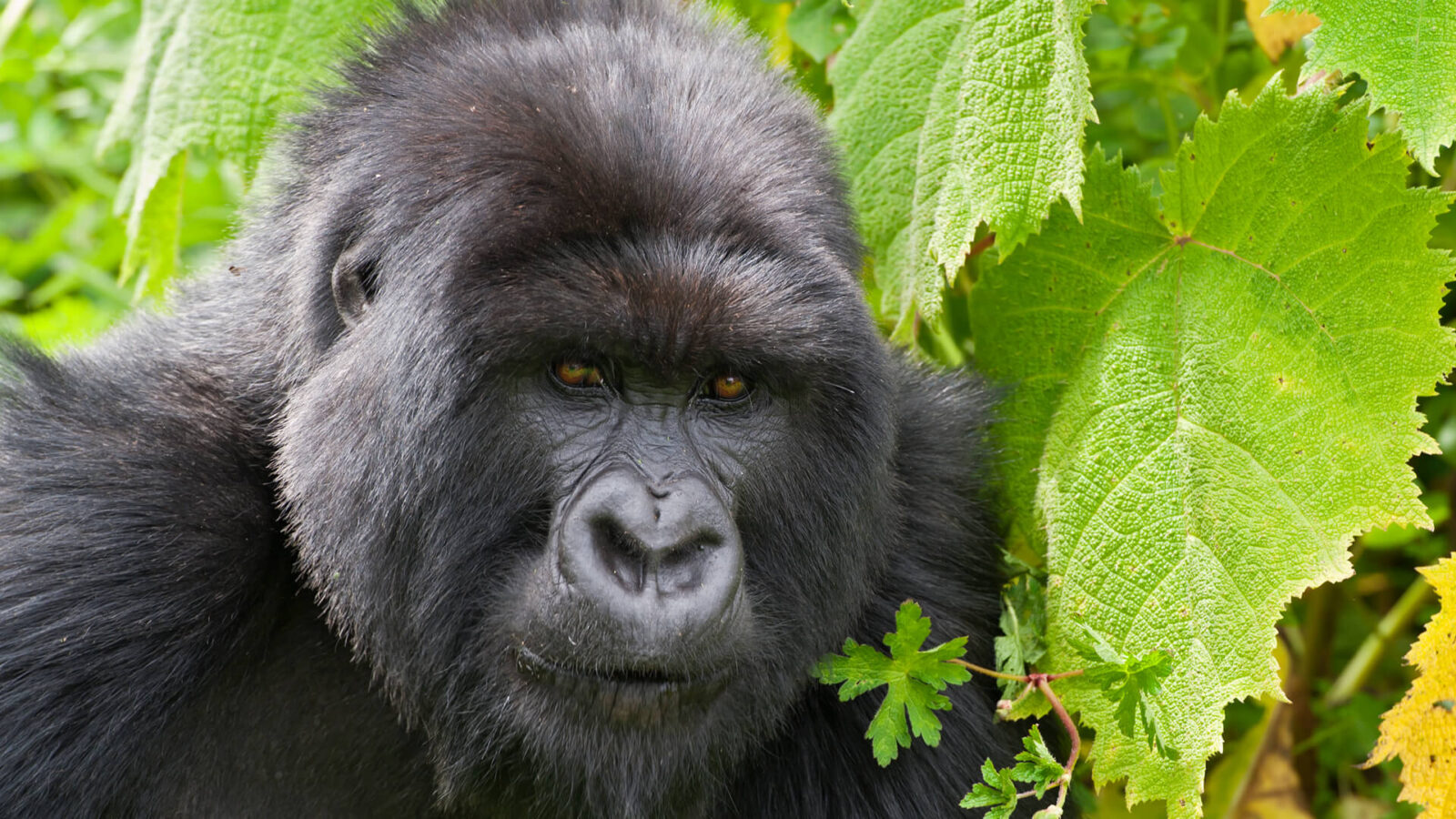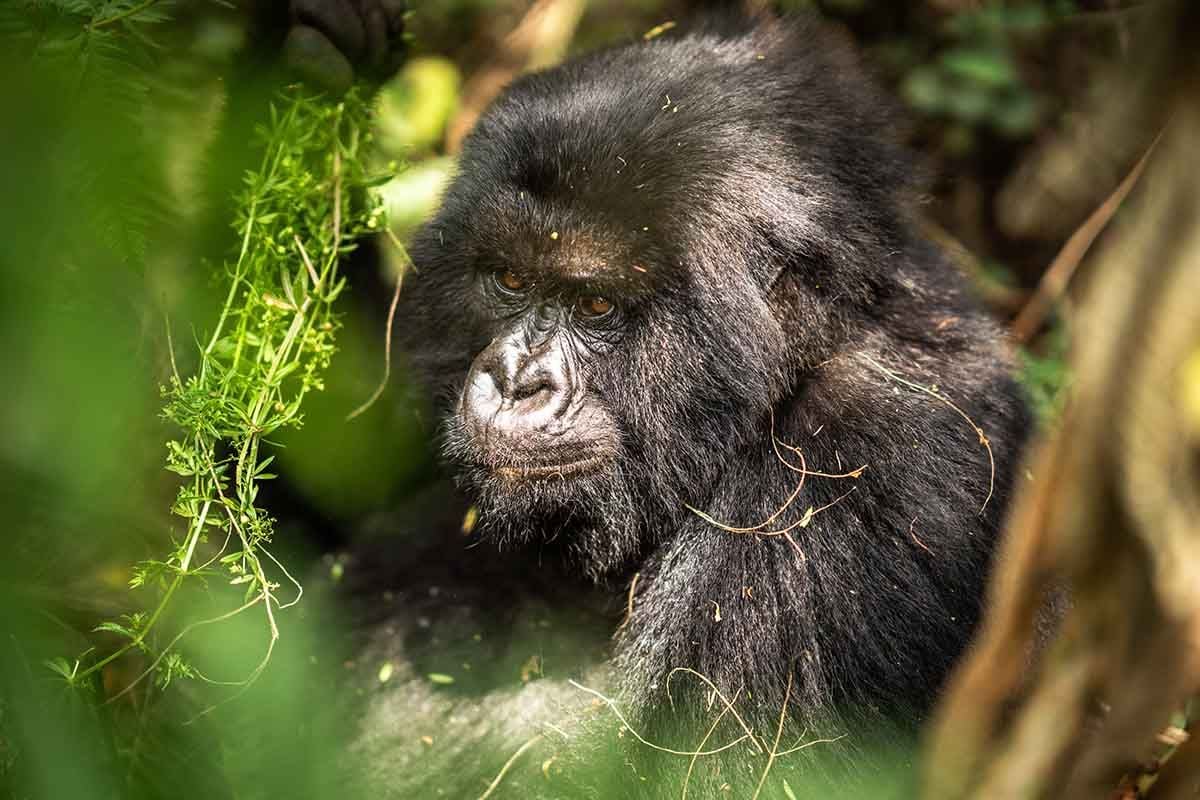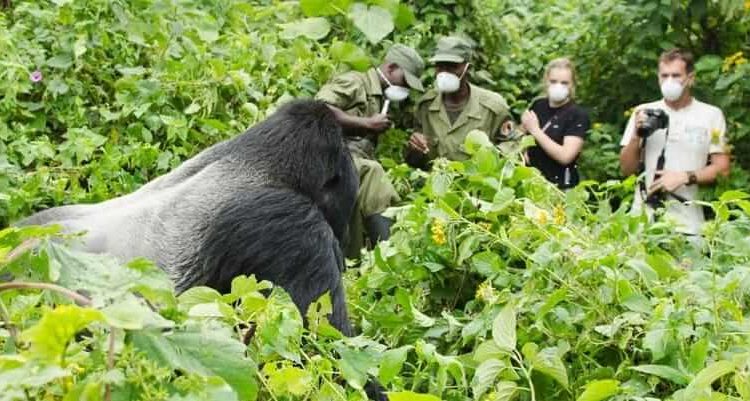Volcanoes Gorilla Tours offers unforgettable journeys into Rwanda’s most iconic safari destinations, combining the thrill of gorilla trekking in Volcanoes National Park with immersive wildlife safaris across Akagera National Park, scenic adventures on Lake Kivu, and cultural encounters in vibrant Kigali. Travelers are guided through activities such as golden monkey tracking, birdwatching, hiking the Virunga volcanoes, and exploring Rwanda’s rich cultural heritage, ensuring every itinerary blends adventure, relaxation, and discovery. With expert-guided tours, luxury safari lodges, and tailor-made itineraries that showcase Rwanda’s diverse attractions, Volcanoes Gorilla Tours is the premier choice for those seeking authentic Africa safaris, wildlife encounters, and once-in-a-lifetime travel experiences.
Things to Know Before Booking Volcanoes Gorilla Tours.
Gorilla permit fees and costs.
A gorilla trekking permit in Volcanoes National Park, Rwanda, is a mandatory document issued by the Rwanda Development Board (RDB) that grants visitors access to track and spend one unforgettable hour with a habituated mountain gorilla family in their natural habitat. Each permit currently costs USD 1,500 per person and is limited to a small number of tourists daily to ensure conservation and minimize human impact on the gorillas. The fee not only secures your trekking experience but also contributes directly to gorilla conservation efforts, community development, and the sustainable protection of the park. Because permits are in high demand and often sell out months in advance, especially during peak travel seasons, it is advisable to book early through an authorized tour operator or directly with the RDB.
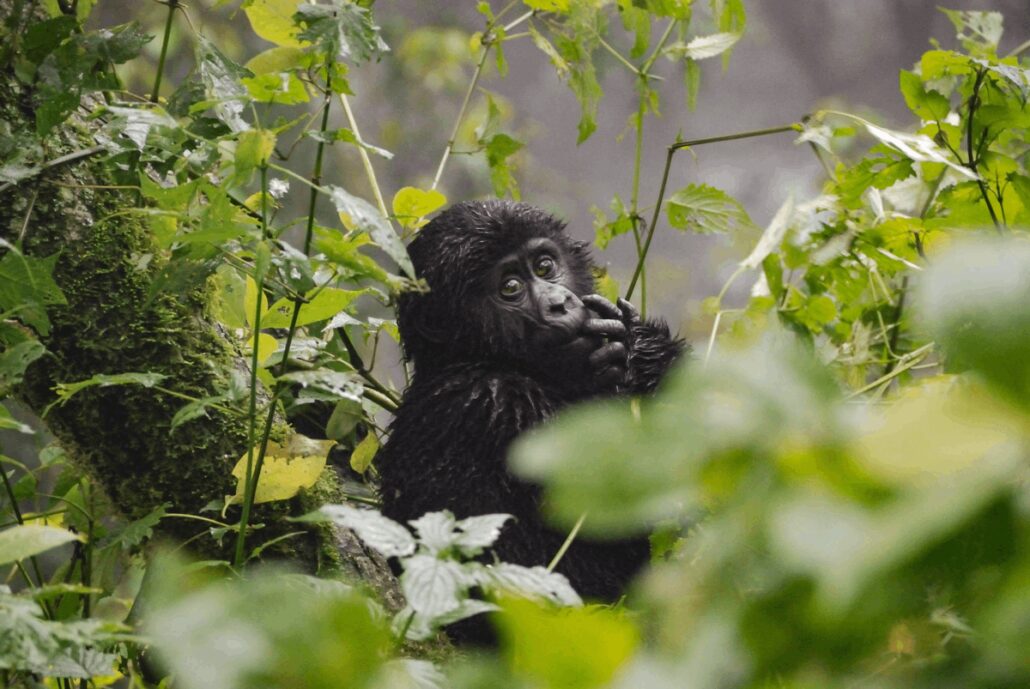
PACKAGES
- 1 Day Kigali City Tour & Genocide
- 2 Days Golden Monkey Trekking
- 2 Days Nyungwe Canopy Walk Safari
- 2 Days Rwanda Cultural Experience
- 3 Days Lake Kivu Safari & Relaxation
- 3 Days Rwanda Gorilla Trekking
- 3 Days Akagera NP Big Five
- 3 Days Nyungwe Chimpanzee
- 4 Days Rwanda Volcano Hiking
- 5 Days Rwanda Birdwatching
Volcanoes gorilla tours: gorilla trekking rules.
Before the Trek
- Age restriction – Only visitors aged 15 years and above are allowed to trek.
- Health check – Visitors showing signs of illness (flu, cough, cold, etc.) are not permitted, as gorillas are highly susceptible to human diseases.
- Group size – A maximum of 8 visitors per gorilla family per day is allowed to reduce stress on the gorillas.
- Permit requirement – You must have a valid gorilla trekking permit (USD 1,500 per person).
During the Trek
- Briefing – All trekkers must attend a pre-trek briefing by park rangers on safety and etiquette.
- Keep your distance – Maintain at least 7 meters (21 feet) from the gorillas at all times.
- Follow the guide – Always stay with your guide and follow instructions carefully.
- No littering – Nothing should be left in the forest; carry out everything you bring in.
- Photography rules – Flash photography is strictly prohibited.
- Noise control – Keep voices low to avoid disturbing the wildlife.
During Gorilla Encounter
- Time limit – You are allowed one hour with the gorillas.
- No touching – Do not attempt to touch or feed the gorillas.
- Posture – Crouch down if a gorilla approaches; avoid direct eye contact as it may be seen as aggression.
- Food & drinks – Eating, drinking, or smoking near the gorillas is forbidden.
- Sanitation – If you need to relieve yourself, dig a hole at least 30 cm deep and cover it completely.
What to pack for volcanoes gorilla tours.
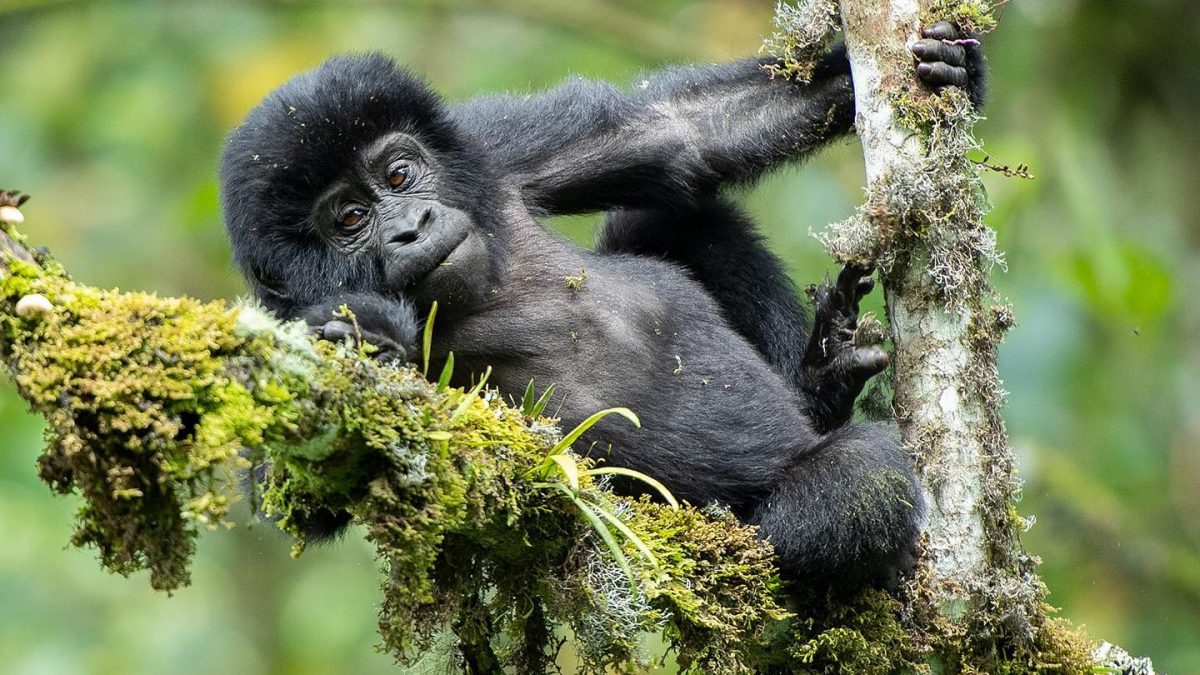
Clothing & Footwear
- Sturdy hiking boots – Waterproof, with good ankle support for muddy and steep terrain.
- Long-sleeved shirts & trousers – To protect from stinging nettles, thorns, and insects.
- Lightweight rain jacket or poncho – Weather is unpredictable, and rain is common in the rainforest.
- Gaiters or long socks – To keep mud, insects, and water out of your boots.
- Gardening gloves – Useful for gripping vegetation and protecting hands from thorns.
- Hat or cap – For sun protection when trekking outside the forest.
Health & Safety Items
- Insect repellent – To guard against mosquitoes and other forest insects.
- Sunscreen & lip balm – Even in cloudy conditions, UV protection is important.
- Personal first-aid kit – Include plasters, antiseptic wipes, and any personal medication.
- Face mask – Often required to minimize the risk of transmitting diseases to gorillas.
Gear & Essentials
- Daypack (waterproof or with a rain cover) – To carry your essentials comfortably.
- Reusable water bottle or hydration pack – Staying hydrated is key during the trek.
- Energy snacks – Light snacks like energy bars or nuts for extra stamina.
- Binoculars – For spotting birds and other wildlife along the way.
- Camera with extra batteries & memory cards – Flash must be disabled when photographing gorillas.
Optional but Useful
- Walking stick – Can be provided by park staff, but you may bring your own for extra support.
- Light sweater or fleece – Mornings can be chilly at high altitudes.
- Small dry bag – To protect electronics and documents from rain.
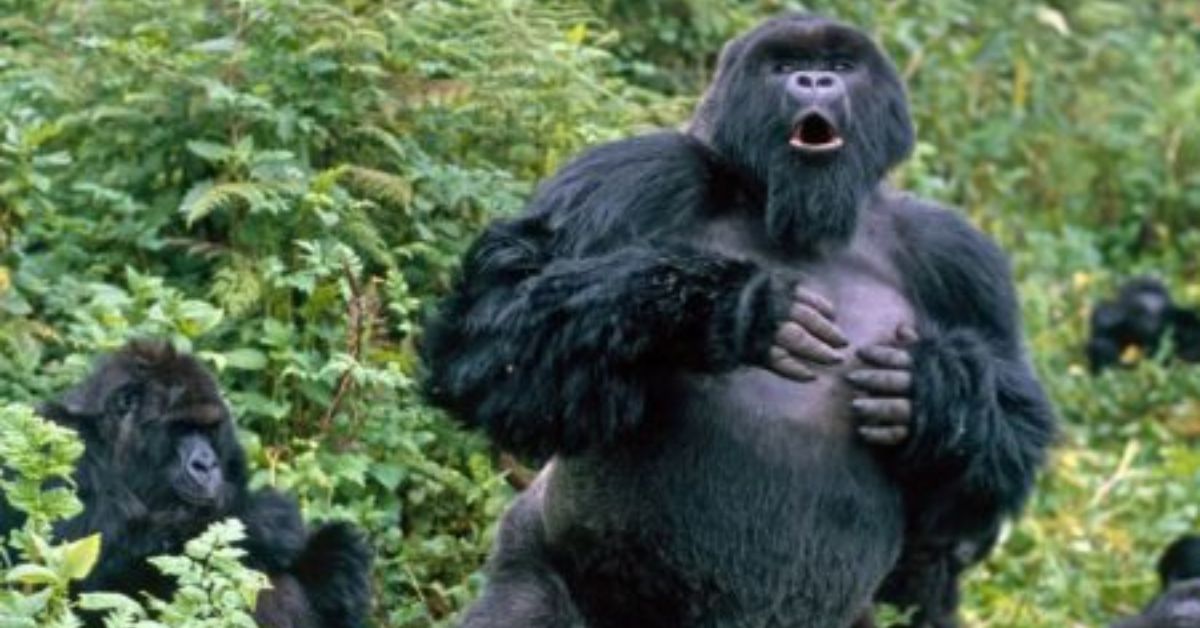
Why Choose Us
Volcanoes Gorilla Tours offers travelers a seamless and unforgettable safari experience in Rwanda, specializing in guided gorilla trekking adventures within Volcanoes National Park. With a team of expert local guides, well-crafted itineraries, and personalized service, the company ensures that every journey is safe, enriching, and tailored to individual preferences. Beyond gorilla trekking, travelers can also explore Uganda, Kenya, Tanzania, and Rwanda’s breathtaking landscapes, rich culture, and diverse wildlife with ease and comfort. By choosing Volcanoes Gorilla Tours, visitors not only enjoy professional and reliable services but also contribute to sustainable tourism and local community development, making their safari both meaningful and memorable.
VOLCANOES NATIONAL PARK
What is Volcanoes National Park?
Nestled in the mist-shrouded highlands of northwestern Rwanda lies Volcanoes National Park, a place where the primeval wilderness still echoes with the calls of mountain gorillas, where volcanic slopes cloak themselves in emerald green, and where conservation has become a lifeline not only for endangered species but also for local communities. This park, known locally as Parc National des Volcans, forms one of the most extraordinary landscapes in Africa. It is part of the larger Virunga Conservation Area, which spans across Rwanda, Uganda, and the Democratic Republic of Congo, and has for decades been celebrated as one of the most biologically rich and culturally resonant destinations on the continent.
Volcanoes National Park is not simply a tourist attraction; it is a living testament to Rwanda’s resilience and vision. Rising from the scars of a turbulent history, Rwanda has redefined itself as a hub of conservation, sustainable tourism, and cultural pride, with Volcanoes National Park at the heart of that transformation. For many, the park’s primary draw is the chance to come face to face with the critically endangered mountain gorilla, a moment described by travelers as life-changing, humbling, and profoundly moving. Yet, beyond the gorillas, the park is a sanctuary of volcanic peaks, golden monkeys, bird species, and alpine vegetation that together form an otherworldly scene.
This is a park that has captured global imagination, whether through the pioneering research of Dian Fossey in the 1960s and 70s or through the modern eco-tourism initiatives that continue to set global standards today. A visit to Volcanoes National Park is not just about travel; it is about stepping into the heart of Africa’s most iconic wilderness and participating in a story of survival, protection, and cultural continuity.
What are the safari activities at Volcanoes National Park?
The hallmark activity in Volcanoes National Park is gorilla trekking. Each morning, small groups of visitors set off with guides and trackers, often trekking for several hours through challenging terrain to reach their allocated gorilla family. The reward, an hour in the company of these great apes, is widely regarded as one of the most profound wildlife encounters in the world. Strict rules govern the trek to ensure the safety of both gorillas and visitors, from maintaining a respectful distance to limiting daily visitor numbers.
Another signature activity is the golden monkey trek, which offers a lighter yet equally enchanting experience. The monkeys’ playful antics, combined with the lush bamboo habitats they inhabit, create a lively and accessible trek suitable even for those who might find gorilla trekking too demanding.
For the adventurous, hiking one of the park’s volcanoes is a highlight. Mount Bisoke, with its stunning crater lake, is a popular one-day trek, while the challenging two-day ascent of Mount Karisimbi, Rwanda’s highest peak at 4,507 meters, appeals to seasoned hikers. Each ascent traverses varying vegetation zones, offering insights into the park’s ecological diversity.
Cultural experiences complement the natural encounters. Visits to the Iby’Iwacu Cultural Village provide an introduction to traditional Rwandan dance, music, and crafts, offering travelers a chance to engage with the heritage of the communities living around the park.
For those interested in conservation history, a trek to Dian Fossey’s tomb at the former Karisoke Research Center site is both poignant and inspiring. It provides a deeper understanding of the sacrifices made to protect gorillas and the legacy that continues to influence conservation efforts globally.
When is the best time to visit Volcanoes National Park?
Volcanoes National Park is a year-round destination, but conditions vary with the seasons. The dry seasons, running from mid-December to February and from June to September, are generally considered the best times to visit. Trails are less muddy, trekking is somewhat easier, and wildlife viewing is more comfortable. These periods coincide with Rwanda’s peak tourism seasons, so demand for permits and accommodation is high.
The rainy seasons, from March to May and again in October and November, present more challenging trekking conditions due to slippery trails and heavy downpours. However, these months also offer unique advantages. The forests are lush and vibrant, photographic opportunities are dramatic, and fewer tourists mean a quieter experience. Gorilla trekking continues year-round regardless of weather, so determined travelers can still enjoy the experience, often with more availability of permits.
Ultimately, the best time to visit depends on personal preference. Those seeking ease of trekking may prefer the dry seasons, while those seeking solitude and dramatic landscapes may find the wet months rewarding.
Where to stay at Volcanoes National Park?
Accommodation around Volcanoes National Park has evolved to match Rwanda’s positioning as a premier luxury eco-tourism destination. Options range from ultra-luxury lodges to more modest guesthouses, ensuring that different traveler preferences are accommodated.
Among the most renowned are Bisate Lodge, with its iconic spherical villas inspired by traditional Rwandan design, and Singita Kwitonda Lodge, known for its understated luxury and sweeping views of the volcanoes. Other notable options include One&Only Gorilla’s Nest and Virunga Lodge, both offering exclusive experiences that blend comfort with proximity to the park.
For mid-range travelers, lodges and hotels in Musanze provide comfortable stays with easy access to the park headquarters. Guesthouses and community lodges also exist, offering budget-friendly options while ensuring that local communities benefit directly from tourism revenue.
What unites all accommodation choices is their emphasis on eco-friendly design, cultural integration, and proximity to the park, ensuring that travelers remain immersed in the spirit of the landscape even while at rest.
Volcanoes National Park travel tips.
Visiting Volcanoes National Park requires thoughtful planning. Gorilla trekking permits must be secured in advance, often several months before travel, due to high demand. The permit cost, set at US$1,500 for international visitors, includes park entry, guides, and trackers but does not cover accommodation or transport.
Physical fitness is important, as treks can last from two to eight hours, often at high altitudes and on uneven terrain. Sturdy hiking boots, waterproof clothing, gloves for gripping vegetation, and layers for changing mountain weather are recommended. Porters are available for hire and provide invaluable assistance in carrying bags while also supporting local livelihoods.
Health considerations should not be overlooked. Visitors are required to be free of infectious illnesses, as gorillas are highly susceptible to human diseases. Vaccinations against yellow fever, and in some cases malaria prophylaxis, are advised. Travel insurance that covers trekking activities is highly recommended.
Respect for the rules during gorilla encounters is essential. Maintaining distance, avoiding direct eye contact with silverbacks, keeping voices low, and refraining from flash photography all ensure the safety of both gorillas and visitors.
What are the conservation efforts at Volcanoes National Park?
Volcanoes National Park is not only a natural treasure but also a beacon of conservation success. The protection of mountain gorillas, once on the brink of extinction, is one of the most celebrated stories in global wildlife conservation. Through strict regulation of tourism, revenue-sharing with communities, and the tireless work of organizations such as the Dian Fossey Gorilla Fund and the Rwanda Development Board, gorilla numbers have steadily increased.
Revenue from gorilla permits plays a crucial role. A significant portion is directed toward community development projects, including schools, healthcare facilities, and infrastructure, ensuring that local communities see tangible benefits from conservation. This has fostered a sense of ownership and reduced human-wildlife conflict.
Culturally, the park holds deep significance. The Virunga volcanoes are steeped in legend and tradition among local communities, and the park has become a place where cultural heritage and ecological preservation intersect. The annual Kwita Izina ceremony, during which newborn gorillas are named, reflects this blend of tradition, conservation, and global awareness.
The legacy of Dian Fossey remains central to the park’s identity. Her groundbreaking research and advocacy not only brought international attention to gorilla conservation but also laid the foundation for the protective measures that continue to bear fruit today.
Why visit Volcanoes National Park?
A journey to Volcanoes National Park is more than a holiday; it is an immersion into one of the most soul-stirring landscapes on Earth. Here, travelers step into a realm where ancient volcanoes pierce the sky, where gorillas move with quiet majesty through mist-draped forests, and where human determination has rewritten the destiny of a species.
The park embodies Rwanda’s transformation into a model of sustainable tourism and conservation. Every step on its trails, every lodge that embraces eco-design, and every encounter with local culture contributes to a larger story of balance between people and nature.
For travelers seeking the extraordinary, Volcanoes National Park offers an experience that transcends sightseeing. It is a place where conservation becomes personal, where culture is celebrated, and where the privilege of encountering mountain gorillas is matched only by the satisfaction of knowing that one’s visit supports their survival.
In the end, the traveler’s takeaway is clear: Volcanoes National Park is not simply to be visited, but to be experienced, respected, and remembered. It is a destination that lingers in memory long after departure, inspiring a deeper appreciation for the fragility and resilience of life.
What is the wildlife at Volcanoes National Park?
The star attraction of Volcanoes National Park is undoubtedly the mountain gorilla. Rwanda is home to over a third of the world’s remaining mountain gorilla population, and Volcanoes National Park shelters more than a dozen habituated families that visitors can trek to see. Each family has its own unique story, hierarchy, and dynamics, offering a fascinating glimpse into the complexity of primate life. Encounters are tightly regulated to minimize disturbance, yet the proximity achieved during a trek allows for extraordinary observation of grooming, feeding, play, and the quiet authority of silverbacks.
Beyond gorillas, the park is home to the rare and endangered golden monkey, a species endemic to the Virunga region. These monkeys, with their striking golden coats, are playful, curious, and often easier to observe in large groups, making them another highlight of any visit.
The park’s terrain is shaped by a chain of volcanoes, including Karisimbi, Bisoke, Sabyinyo, Gahinga, and Muhabura. These dormant and extinct volcanoes rise dramatically from the forest, their slopes cloaked in dense bamboo and montane forest, and their summits often lost in drifting mist. Climbing these volcanoes is an adventure in itself, rewarding trekkers with breathtaking vistas of the surrounding landscapes and, at times, crater lakes shimmering at the top.
Birdlife in Volcanoes National Park is another hidden treasure. More than 200 species have been recorded, including the Rwenzori turaco and the handsome francolin, making the park a rewarding destination for birdwatchers. The vegetation zones, ranging from bamboo forests to alpine meadows, provide habitats for a diverse array of flora and fauna.
Culturally, the park is interwoven with human stories. The presence of local communities, cultural villages, and the enduring legacy of Dian Fossey’s Karisoke Research Center contribute to the park’s multifaceted identity as both a natural and cultural attraction.
How to get to Volcanoes National Park?
Volcanoes National Park lies in the Musanze District of northern Rwanda, bordering Uganda’s Mgahinga Gorilla National Park and the Democratic Republic of Congo’s Virunga National Park. This strategic location positions it as a cornerstone of the Virunga Massif, a chain of volcanic mountains that dominate the skyline and shape the ecology of the entire region.
Accessibility is one of the park’s greatest advantages. Unlike some remote African wildernesses that require days of overland travel, Volcanoes National Park is located just about two and a half hours by road from Kigali International Airport. This short transfer means that travelers arriving in Rwanda can be trekking gorillas in the misty forests the very next day, a convenience that few other destinations can match. The road journey from Kigali is itself scenic, winding through terraced hillsides, vibrant villages, and views of the dramatic volcanic chain.
For visitors seeking luxury and efficiency, private transfers and even helicopter flights from Kigali to lodges near the park are possible. Musanze town, formerly known as Ruhengeri, serves as the main gateway to the park. It is well-developed with accommodation, banks, restaurants, and cultural centers, making it a comfortable base for exploration. The park headquarters at Kinigi, a short drive from Musanze, is where treks begin each morning, permits are checked, and briefings are conducted.
This accessibility underscores why Volcanoes National Park is often described as one of the most visitor-friendly primate trekking destinations in Africa. It strikes a perfect balance between remote wilderness appeal and modern travel convenience.
VOLCANOES GORILLA TOURS – POPULAR ITINERARIES
Discover our Uganda gorilla trekking safaris tailored for every traveler—solo adventurers, families, budget explorers, or luxury seekers. Each package includes permits, transport, accommodation, meals, and park fees. From short getaways to extended adventures, we have the perfect option for you.
The gorilla trekking experience
Gorilla trekking is one of the most sought-after wildlife encounters in the world, offering travelers the rare chance to stand face-to-face with the endangered mountain gorillas in their natural habitat. Unlike a typical safari, where you observe animals from the comfort of a vehicle, gorilla trekking is a deeply immersive, on-foot journey through dense forests, steep hills, and tangled vegetation in search of these gentle giants. The experience is not physically challenging but profoundly rewarding, leaving trekkers with unforgettable memories.
The Trekking Journey
The adventure begins early in the morning with a briefing from park rangers and guides. Visitors are divided into small groups, usually limited to a maximum of eight people, to minimize the impact on the gorillas and ensure an intimate experience. Each group is assigned a specific gorilla family to track, often chosen based on the fitness level of the participants and the known location of the gorillas.
The trek itself can last anywhere from one to several hours, depending on the movement of the gorillas. Trekkers hike along rugged terrain—climbing hills, crossing streams, and pushing through thick undergrowth. Along the way, guides share insights about the forest ecosystem, pointing out plants, birds, and other wildlife that inhabit the same environment as the gorillas.
Why go gorilla trekking
Unlike most wildlife experiences, gorilla trekking is not just about the animals themselves but also about the journey to find them. The combination of adventure, physical exertion, and the anticipation of the encounter makes the final moment deeply fulfilling.
The rarity of the experience adds to its significance. Mountain gorillas exist only in a handful of protected areas in East and Central Africa, making each trek not only a privilege but also a contribution to conservation. The high cost of trekking permits plays a vital role in funding protection efforts and supporting local communities, ensuring that gorillas have a future.
Face-to-face with the gorillas
Once the gorillas are located, trekkers are allowed to spend a strictly regulated one hour in their presence. This rule helps reduce stress on the animals and lowers the risk of human-to-gorilla disease transmission.
During this hour, visitors often find themselves mesmerized by the gorillas’ behavior. Watching a silverback—the dominant male—command his family with quiet authority, observing mothers gently caring for their young, and seeing juveniles playfully chase each other provides a glimpse into the gorillas’ complex social structures.
The sheer proximity—sometimes just a few meters away—creates an emotional connection that words can hardly capture. The gorillas, though wild, often show little concern for human presence, going about their daily routines of feeding, grooming, and resting.
Prepare for a lifetime experience
Gorilla trekking requires a moderate to high level of fitness. The hikes can be steep, muddy, and unpredictable, with weather shifting suddenly in the rainforest. Porters are often available to assist with carrying bags, making the trek more manageable.
Beyond the physical challenge, the experience is deeply emotional. Many trekkers describe feelings of awe, humility, and even spiritual connection while standing so close to a species that shares more than 98% of its DNA with humans. It is a reminder of our shared ancestry and the delicate balance of life on earth.
Endnotes
Gorilla trekking is more than a wildlife excursion—it is a transformative journey that combines adventure, conservation, and human connection. It challenges the body, stirs the emotions, and leaves a lasting imprint on the heart. For many, it becomes the highlight of all their travels, a once-in-a-lifetime experience that cannot be replicated elsewhere.
Rwanda at a Glance: The Land of a Thousand Hills
A Country with a Story to Tell
Nestled in the heart of East-Central Africa, Rwanda has often been described as small in size, but immense in character. Known worldwide as the “Land of a Thousand Hills”, Rwanda is a country that blends breathtaking landscapes, rich culture, unforgettable wildlife encounters, and an inspiring story of resilience. Despite its tragic past, Rwanda has emerged as one of Africa’s most forward-looking nations — safe, clean, and remarkably well organized. For travelers seeking both beauty and meaning in their journeys, Rwanda offers an experience unlike anywhere else.
Location and Identity
Rwanda sits in East-Central Africa, bordered by Uganda to the north, Tanzania to the east, Burundi to the south, and the Democratic Republic of Congo to the west. Its compact size — just over 26,000 square kilometers — makes it one of Africa’s smallest countries, yet it is densely populated with about 13 million people.
The nickname “Land of a Thousand Hills” is more than poetic; it captures the essence of the country’s landscape. Rolling green hills stretch as far as the eye can see, dotted with villages, farms, and winding roads that lead travelers to remote corners of the country.
The capital city, Kigali, lies at the heart of this hilly terrain. Clean, modern, and orderly, it is a symbol of Rwanda’s remarkable transformation. Here, visitors are immediately struck by a sense of calm and safety unusual in many bustling African capitals.
Language, Culture, and Currency
Rwanda’s official and widely spoken language is Kinyarwanda, though English, French, and Swahili are also common, reflecting both colonial history and Rwanda’s role in regional trade. For visitors, this multilingual society makes communication relatively easy, especially in tourism hubs.
The currency is the Rwandan Franc (RWF), though US dollars are often accepted in lodges and for gorilla trekking permits. Still, having local currency on hand makes navigating markets and smaller purchases more convenient.
History and Resilience
Pre-Colonial and Colonial Roots
Historically, Rwanda was a centralized kingdom ruled by a monarch. This system created a strong sense of identity, though colonial powers later reshaped the nation’s political and social structures. First Germany, and later Belgium, colonized Rwanda, leaving deep imprints that contributed to tensions in later years.
The 1994 Genocide Against the Tutsi
In 1994, Rwanda faced one of the darkest chapters in modern history: the Genocide Against the Tutsi, in which around one million people were killed in just 100 days. Families, communities, and the entire fabric of society were torn apart. It was a tragedy that stunned the world and left Rwanda at the brink of collapse.
Rebirth and Transformation
From the ashes of this unimaginable loss, Rwanda has forged a new identity. The country has embraced reconciliation, unity, and development as guiding principles. Today, Rwanda stands as a model of peace, security, and growth. It is widely regarded as one of the cleanest, safest, and most forward-thinking nations in Africa. Visitors cannot help but feel inspired by this remarkable transformation.
Kigali – The Gateway to Rwanda
For most travelers, the journey begins in Kigali, Rwanda’s vibrant capital. The city is more than a gateway; it is a destination in its own right.
Highlights include:
-
Kigali Genocide Memorial: A deeply moving site that honors victims and provides a powerful educational experience about Rwanda’s past.
-
Nyamirambo Women’s Center: Offering community-led tours that showcase daily life, traditional cooking, and women’s empowerment projects.
-
Kimironko Market: A bustling hub of food, crafts, fabrics, and local life.
-
Modern Cafés, Restaurants, and Art Galleries: Kigali has a thriving contemporary scene, with chic coffee shops, stylish restaurants, and art galleries that reflect the country’s creative energy.
Unlike many African capitals, Kigali feels safe and easy to navigate. Its organized streets, green spaces, and cleanliness are a testament to Rwanda’s commitment to progress.
Rwanda’s Natural Wonders and Wildlife
Volcanoes National Park
Located in the Virunga Mountains, Volcanoes National Park is Rwanda’s crown jewel. It is home to the endangered mountain gorillas, a once-in-a-lifetime wildlife experience that draws visitors from across the globe. Trekking through misty forests to spend an hour with these gentle giants is considered one of the most profound encounters in wildlife tourism. The park also shelters golden monkeys and offers challenging hikes to volcanic peaks such as Mount Karisimbi and Mount Bisoke.
Dian Fossey
In the mist-shrouded mountains of Central Africa, one woman’s passion and defiance forever changed the fate of the world’s most endangered great apes — the mountain gorillas. Dian Fossey’s name today is inseparable from their survival, her life a testament to courage, science, and unyielding devotion to nature.
Early Life and Path to the Mountains
Born in San Francisco in 1932, Dian Fossey developed an early love for animals but never imagined she would one day live among gorillas. Initially trained as an occupational therapist, her life took a dramatic turn after a self-funded trip to Africa in 1963. That journey ignited an obsession that would define her destiny. In the heart of the Virunga Mountains, she met anthropologist Louis Leakey, who had already championed the work of Jane Goodall and Biruté Galdikas. Recognizing Fossey’s determination, Leakey encouraged her to study mountain gorillas — thus beginning one of the most extraordinary chapters in wildlife conservation.
Life Among the Gorillas
In 1967, Dian Fossey established the Karisoke Research Center between Mount Karisimbi and Mount Visoke (from which the name “Karisoke” derives) in Rwanda’s Volcanoes National Park. Her goal was simple yet profound: to understand the mountain gorillas and protect them from extinction. Living at high altitudes under harsh conditions, Fossey immersed herself in their world. She adopted their gestures, mimicked their sounds, and gradually earned their trust.
Her deep empathy and patience allowed her to observe intimate behaviors previously unseen — from playful interactions to maternal tenderness. Through her pioneering work, Fossey dismantled myths that gorillas were violent beasts, revealing instead their peaceful and intelligent nature.
A Fierce Protector
But Fossey’s research was more than science — it was a crusade. As she witnessed the brutal toll of poaching and habitat destruction, her focus turned to direct protection. She formed anti-poaching patrols and became a formidable opponent to those threatening gorillas. Her fearless tactics, though controversial, deterred countless poachers and exposed the ruthless trade in gorilla trophies and infants.
Her 1983 book, Gorillas in the Mist, chronicled her experiences and brought global awareness to the plight of the mountain gorillas. The book later inspired the 1988 film of the same name, starring Sigourney Weaver, which immortalized her legacy for generations to come.
Tragic Death and Enduring Legacy
Dian Fossey’s fierce dedication came at a high cost. In December 1985, she was found murdered in her cabin at Karisoke, a case that remains unsolved to this day. Yet her death did not end her mission. Her research center continues to thrive, now managed by the Dian Fossey Gorilla Fund, advancing both conservation and community education in Rwanda and the Democratic Republic of Congo.
Today, because of the groundwork she laid, the mountain gorilla population — once on the brink of extinction — has risen steadily, making it one of the world’s greatest conservation success stories.
The Spirit of the Mountains
Dian Fossey’s story is one of love, isolation, and sacrifice. She bridged the vast divide between humanity and the wild, proving that understanding is the first step toward protection. Every encounter with a mountain gorilla today — every gaze into their gentle, human-like eyes — carries her spirit.
She once wrote, “When you realize the value of all life, you dwell less on what is past and concentrate more on the preservation of the future.” In those words lies the true meaning of her life — and the enduring echo of the mountains she called home.
Kwita Izina
In the verdant heart of Rwanda’s Volcanoes National Park, amid rolling mist and towering bamboo forests, an extraordinary celebration unfolds each year — Kwita Izina. This is not just a ceremony; it is a heartfelt tradition that unites conservation, culture, and community in a powerful symbol of Rwanda’s commitment to protecting its most iconic species — the mountain gorilla.
The Origins of Kwita Izina
Kwita Izina is derived from an old Rwandan cultural practice meaning “to give a name.” Traditionally, Rwandan families would hold a joyful ceremony to name a newborn child — a rite of passage filled with blessings, dance, and unity. In 2005, the Rwanda Development Board (RDB) and the Dian Fossey Gorilla Fund revived this custom with a conservation twist: naming newborn gorillas.
What began as a small event at the foot of the Virunga Mountains has grown into one of Africa’s most celebrated conservation festivals. Each year, new baby gorillas born in Volcanoes National Park are given names during the Kwita Izina ceremony, symbolizing Rwanda’s deep respect for life and nature.
A Celebration of Conservation and Culture
Kwita Izina is far more than a naming event — it is a national statement of pride. The celebration attracts thousands of people, from local communities and rangers to global conservationists, celebrities, and world leaders. Set against the stunning backdrop of Musanze, the event showcases Rwanda’s cultural richness through traditional music, dance, and storytelling.
The names given to the gorillas often carry deep meaning, inspired by conservation milestones, cultural values, or the gorillas’ personalities and circumstances of birth. Names such as “Ubuzima” (Life), “Inkingi” (Pillar), and “Intare” (Lion) reflect Rwanda’s language, spirit, and commitment to protection. Each name also serves a scientific purpose — helping trackers and researchers monitor individual gorillas throughout their lives.
Community Empowerment and Ecotourism Impact
At the heart of Kwita Izina is the connection between conservation and community. The ceremony recognizes the people living near Volcanoes National Park — communities who share their land and resources with wildlife. Through Rwanda’s revenue-sharing programs, a portion of gorilla trekking permit fees directly funds local projects such as schools, clinics, and clean water systems.
This partnership has transformed the once-threatened gorillas into a source of national pride and sustainable income. Tourism driven by gorilla trekking now contributes significantly to Rwanda’s economy, empowering communities and reducing human-wildlife conflict. Kwita Izina stands as the living proof that when people benefit from conservation, wildlife thrives.
A Global Symbol of Hope
Over the years, Kwita Izina has attracted global icons — from conservationists like Dr. Jane Goodall to celebrities and leaders including Naomi Campbell and Prince Charles. Their participation amplifies Rwanda’s message to the world: that conservation succeeds when it is rooted in culture, unity, and respect for nature.
Today, thanks to initiatives like Kwita Izina, the population of mountain gorillas has grown steadily. Once teetering on the brink of extinction, they are now a conservation success story — a triumph shared by Rwanda and the global community.
The Legacy of a Name
Each name bestowed during Kwita Izina is more than a word — it is a promise. It carries hope for the gorillas’ future and reflects the human spirit that protects them. As drums echo across the hills of Musanze and the mist lifts from the volcanoes, Kwita Izina reminds the world that conservation is not just science; it is culture, compassion, and continuity.
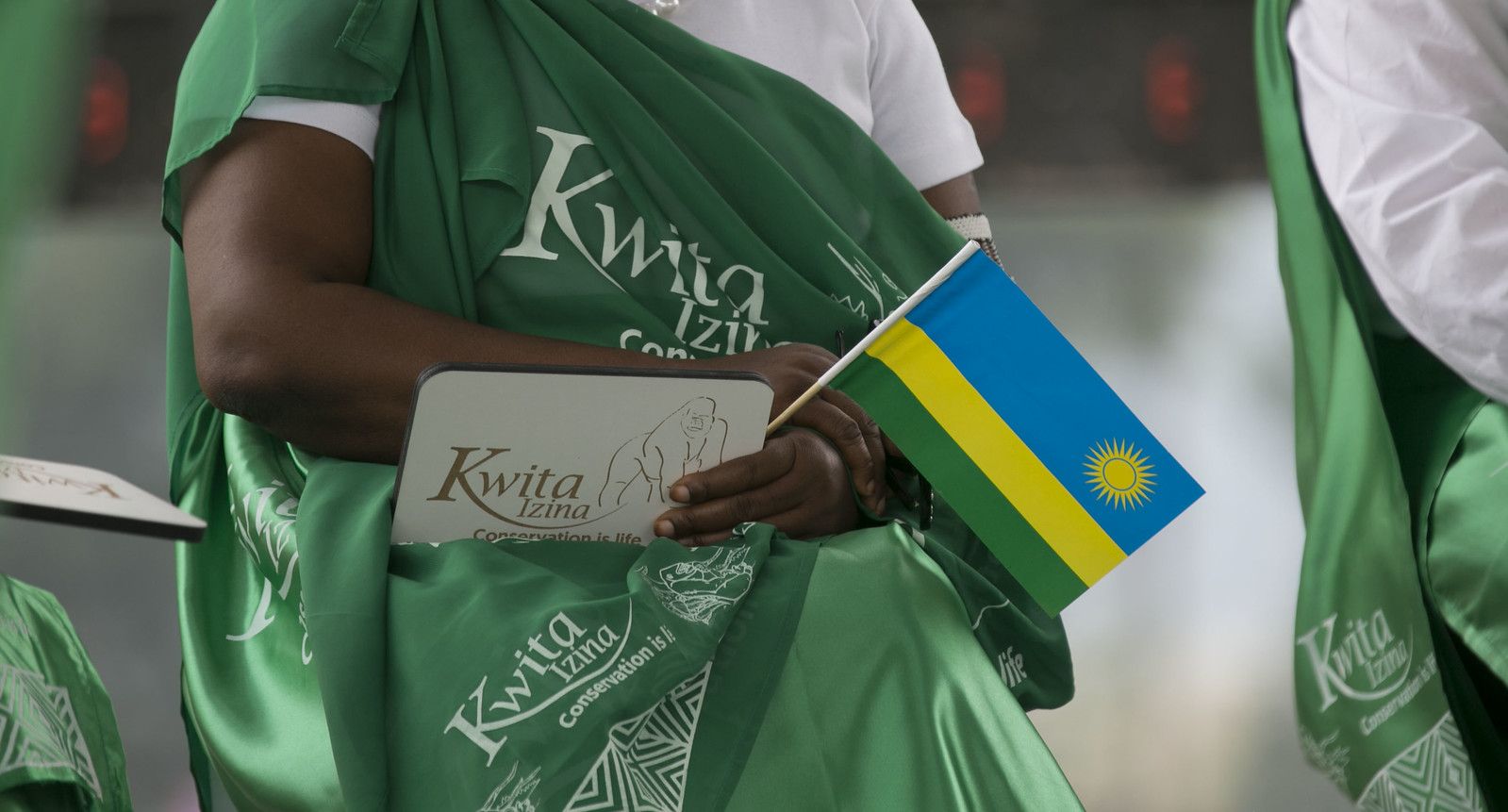
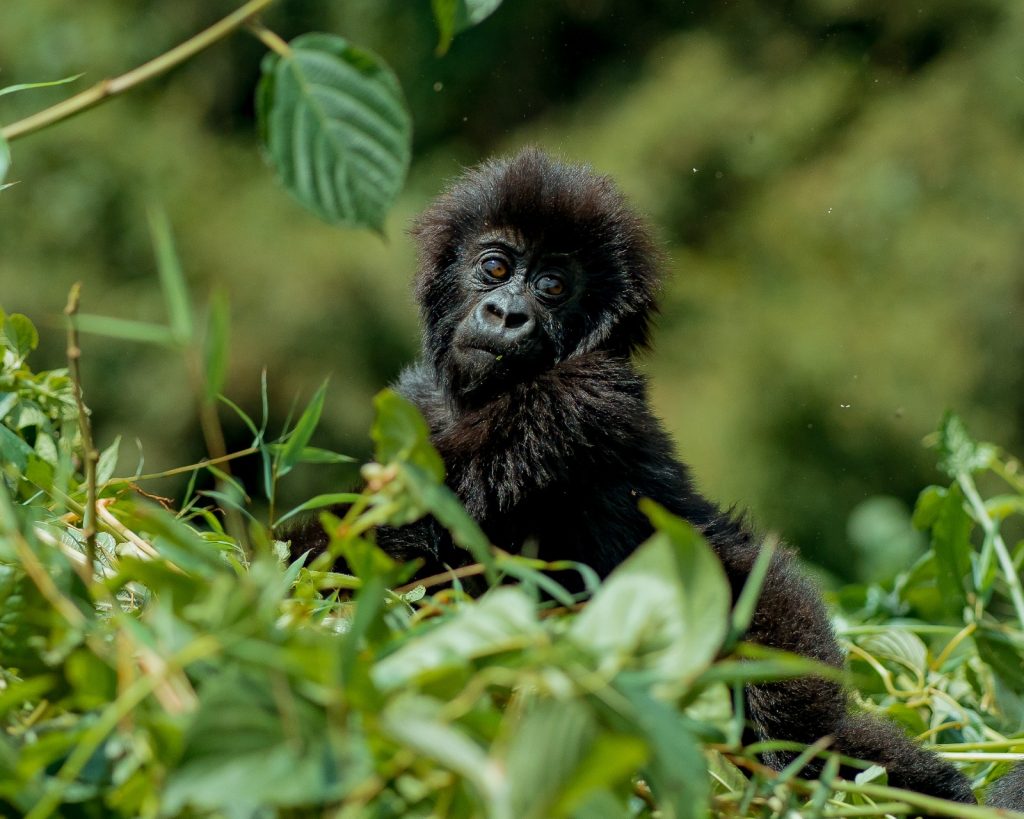
Nyungwe Forest National Park
In the southwest lies Nyungwe Forest, one of the oldest rainforests in Africa. It is famed for its chimpanzee trekking and the canopy walkway — a suspended bridge that offers breathtaking views of the forest canopy. Nyungwe is also a paradise for birdwatchers, with over 300 species, including many endemics.
Akagera National Park
In contrast to the forests, Akagera National Park in the east offers a classic savannah safari experience. Restored in recent years, Akagera is now home to the Big Five: lions, elephants, rhinos, leopards, and buffaloes. Scenic lakes filled with hippos and crocodiles, along with giraffes, antelopes, and rich birdlife, make this park a must for safari lovers.
Lake Kivu
Stretching along the border with the Democratic Republic of Congo, Lake Kivu is Rwanda’s most relaxing retreat. Its calm waters and sandy shores are perfect for boat trips, kayaking, or simply unwinding after a gorilla trek. Coffee tours along the lake’s shores provide insight into one of Rwanda’s finest exports.
Culture and People
Unity and Identity
In the years following the genocide, Rwanda has worked tirelessly to build unity. Ethnic divisions have been deliberately replaced with a strong sense of shared national identity. Visitors often notice the pride Rwandans take in their country and their determination to shape a brighter future.
Music and Dance
Rwanda’s cultural heartbeat lies in its music and dance. The Intore dance, performed with spears and elaborate headdresses, is one of the country’s most famous traditional art forms. Modern Rwandan music, blending Afrobeat, gospel, and hip-hop, also thrives in Kigali’s vibrant nightlife.
Cuisine
Rwandan food reflects its agricultural richness. Staples include ugali (maize porridge), isombe (cassava leaves with groundnut paste), and the beloved brochettes, skewered and grilled meat served with vegetables. Rwanda is also world-renowned for its coffee and tea, both of which are integral to its economy and culture.
Crafts and Traditions
Rwanda’s artisans are celebrated for their Agaseke peace baskets, intricately woven and symbolic of unity. Visitors can also find ceramics, beadwork, and textiles that make meaningful souvenirs while supporting local livelihoods.
Travel and Logistics
Getting There
Most travelers arrive via Kigali International Airport (KGL), which has connections to major hubs across Africa, Europe, and the Middle East. The airport is modern, efficient, and conveniently located close to the city.
Getting Around
Rwanda’s small size and good network of paved roads make travel surprisingly easy. Car rentals and private tours are common, and distances between destinations are manageable. Internal flights are rare, as they are unnecessary given the country’s compact geography.
Visas and Entry
Rwanda offers e-visas online and visa-on-arrival options for many nationalities, making entry straightforward. The East Africa Tourist Visa also allows combined travel to Rwanda, Uganda, and Kenya.
Health and Safety
Travelers are required to show proof of a yellow fever vaccination, and malaria prophylaxis is strongly recommended. Rwanda is generally considered one of the safest African countries for visitors.
When to Visit Rwanda
Rwanda’s climate is temperate year-round, thanks to its high elevation.
-
Dry Seasons (June–September, December–February): Ideal for gorilla trekking, chimpanzee tracking, and hiking. Trails are more accessible, and wildlife viewing is at its best.
-
Rainy Seasons (March–May, October–November): The landscape is lush and beautiful, with fewer tourists and lower prices, but trekking can be muddy and more challenging.
Why Visit Rwanda?
Rwanda offers travelers something rare: a combination of profound natural beauty, unique wildlife, and a deeply inspiring story of recovery and progress. It is one of the few places on Earth where you can encounter mountain gorillas in the wild, a privilege that alone makes the journey worthwhile.
But Rwanda is more than gorillas. It is a nation that has risen from unimaginable tragedy to become a beacon of peace, safety, and progress. Its compact size makes it easy to experience culture, wildlife, and relaxation all in a single trip, while its people embody warmth, resilience, and hospitality.
The Pearl of the Thousand Hills
Rwanda is a destination that captures both the heart and the imagination. From gorilla trekking in misty forests to relaxing on Lake Kivu’s shores, from learning about its past at the Kigali Genocide Memorial to experiencing its vibrant culture through dance, music, and cuisine, every moment in Rwanda leaves an impression.
For travelers seeking not only adventure but also meaning, Rwanda offers an unforgettable journey. It is a country that teaches resilience, celebrates unity, and welcomes the world to share in its transformation. Truly, Rwanda is a gem at the heart of Africa — one that deserves to be discovered and cherished.
Gorilla trekking in Bwindi and Mgahinga from Kigali.
Experience unforgettable gorilla trekking in Uganda’s Bwindi Impenetrable and Mgahinga National Parks, starting conveniently from Kigali. Our tours include permits, transport, accommodation, meals, and park fees—perfect for both quick getaways and in-depth adventures.
The “Behind the Scenes” Gorilla Trekking experience in Rwanda
The “Behind the Scenes” Gorilla Trekking experience in Rwanda is a special conservation-focused tour offered in Volcanoes National Park, designed for travelers who want to go beyond the standard gorilla trekking adventure. Unlike the usual trek where visitors spend one hour with habituated gorilla families, this experience gives a deeper look into the science, conservation, and protection work that makes Rwanda’s gorilla tourism so successful.
Gorilla habituation experience.
The Gorilla Habituation Experience is a unique adventure offered only in Uganda’s Bwindi Impenetrable National Park, allowing visitors to spend up to four hours with a wild gorilla family under habituation. Unlike regular gorilla trekking, where the gorillas are already accustomed to human presence, this experience gives you a behind-the-scenes look at the gradual process of making gorillas comfortable around people. Guided by researchers, trackers, and rangers, you’ll observe gorillas in their natural habitat as they feed, play, and interact, while also learning about conservation efforts. With limited permits issued each day, this rare encounter offers a deeper, more intimate connection with the endangered mountain gorillas.
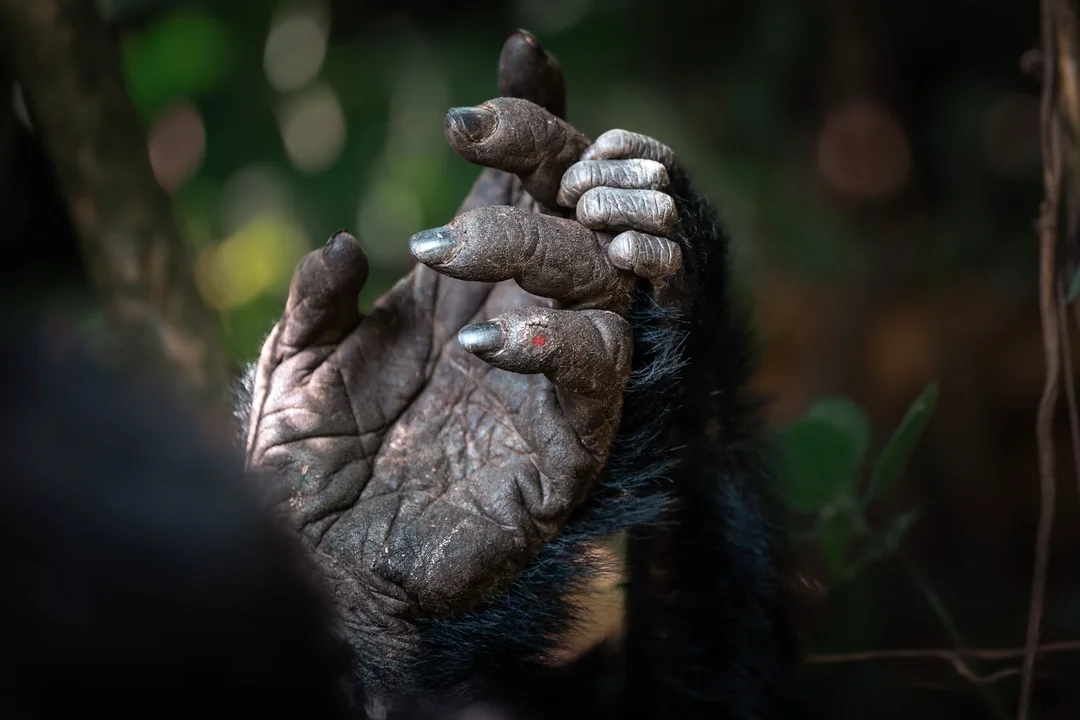
Types
- Mountain Gorilla (Gorilla beringei beringei)
- Eastern Lowland Gorilla / Grauer’s Gorilla (Gorilla beringei graueri)
Western Gorilla (Gorilla gorilla)
- Western Lowland Gorilla (Gorilla gorilla gorilla)
- Cross River Gorilla (Gorilla gorilla diehli)
Silverback gorilla
A dominant adult male leader of a gorilla group, easily recognized by the distinctive silver hair across his back. Powerful yet gentle, he protects, guides, and maintains harmony within his family troop deep in the African forests.
- Average Weight: 195 kg
- Average Height: 1.5 m
- Average Strength: 800 Kg
- Average Diet: 18 Kg
Appearance
Gorillas are the largest primates, with powerful, muscular bodies covered in dark hair that ranges from black to brownish-gray. Adult males develop a distinctive silver patch on their backs, earning them the name silverbacks. They have broad chests, long arms, and expressive brown eyes set in nearly hairless faces that reveal a range of emotions. Despite their immense size and strength, gorillas move with a calm, deliberate grace, perfectly adapted to the dense forests they call home.
Way of life
Gorillas live in close-knit family groups known as troops, typically led by a dominant silverback who provides protection and leadership. Their days are spent foraging for leaves, fruits, shoots, and stems, resting, and grooming one another — a behavior that strengthens social bonds. Communication within the group is rich and varied, using gestures, vocal calls, and facial expressions to express affection, warning, or playfulness. They build fresh nests each evening from leaves and branches, often on the ground or in trees, and live peacefully unless threatened. Gentle and intelligent, gorillas embody a harmonious balance between strength, family, and the rhythms of their lush forest homes.
Reproduction
Gorilla reproduction centers around the strong social structure of their family groups, where the dominant silverback mates with several females within the troop. Female gorillas reach maturity at about eight years old, while males mature later, around twelve to fifteen years. After mating, the female undergoes a gestation period of about eight and a half months, usually giving birth to a single infant. Newborn gorillas are small and fragile, clinging to their mothers’ chests for warmth and security. As they grow, they begin to ride on their mothers’ backs and learn essential survival skills through play and observation. Mothers are highly protective and nurturing, while the silverback provides constant vigilance, ensuring the safety and unity of his family.
Where to find them
Gorillas are found only in the tropical and subtropical forests of central and eastern Africa, where their habitat ranges from misty volcanic mountains to dense lowland rainforests. The mountain gorillas, the most famous subspecies, live in the Virunga Mountains — a chain of volcanoes spanning Rwanda’s Volcanoes National Park, Uganda’s Bwindi Impenetrable and Mgahinga Gorilla National Parks, and the Democratic Republic of Congo’s Virunga National Park. In contrast, lowland gorillas — both western and eastern species — inhabit the thick forests and swampy regions of countries like Cameroon, the Central African Republic, Republic of Congo, Gabon, and DRC. These remote, lush habitats provide the food, shelter, and seclusion gorillas need to thrive, making them true guardians of Africa’s wildest and most untouched landscapes.
Other volcanoes gorilla tours destinations.
Where to see gorillas other than Volcanoes National Park.
Bwindi Impenetrable Forest National Park
Home to half the world’s remaining mountain gorillas. The park offers 160 permits daily based on first-come, first-served.
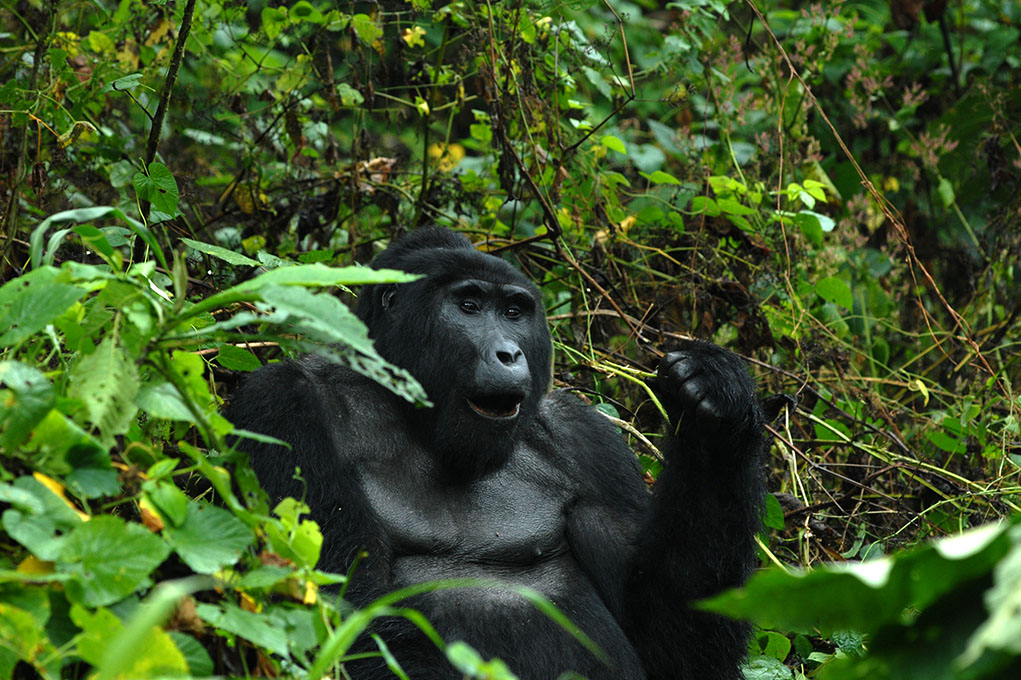
Mgahinga Gorilla National Park
Uganda’s smallest park, famed for its rare mountain gorillas, golden monkeys, and the dramatic volcanic peaks of the Virunga range.
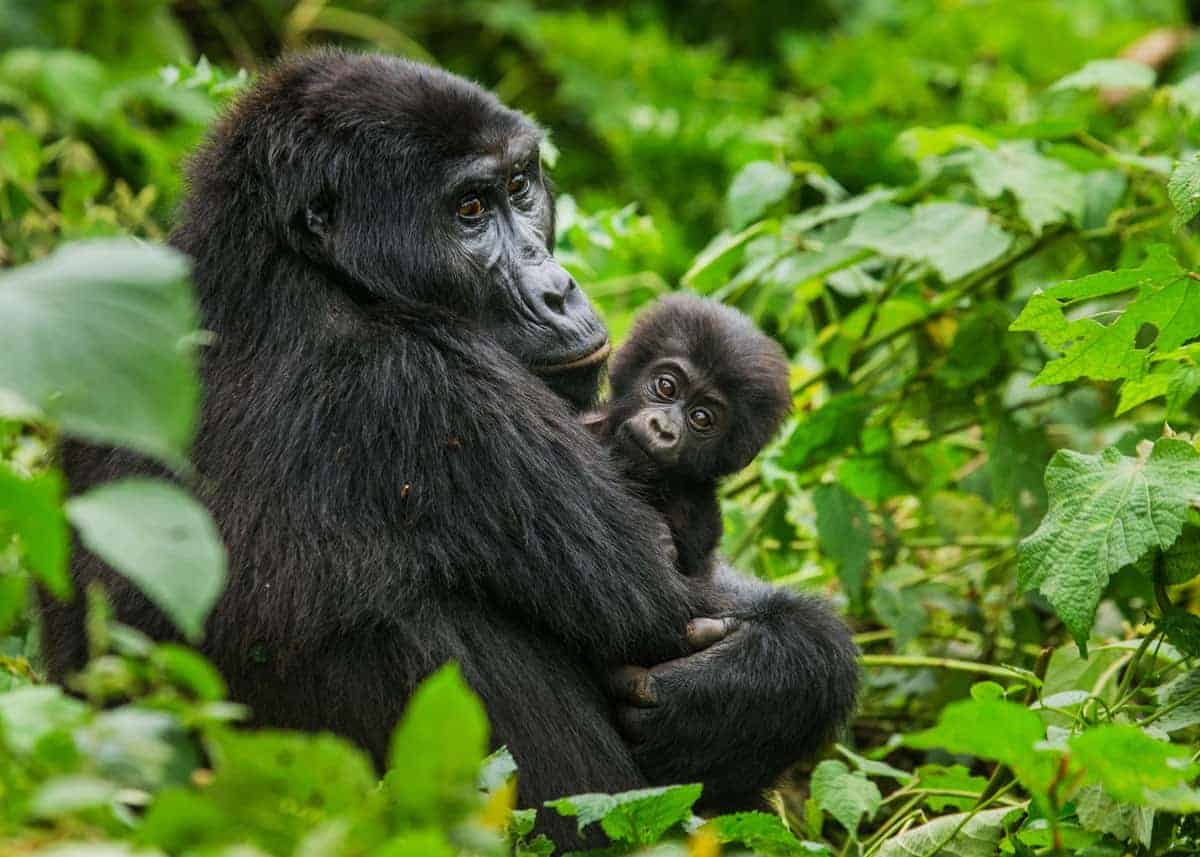
Virunga National Park
Found in the Democratic Republic of Congo is Africa’s oldest national park, renowned for its endangered mountain gorillas, active volcanoes, and rich biodiversity.
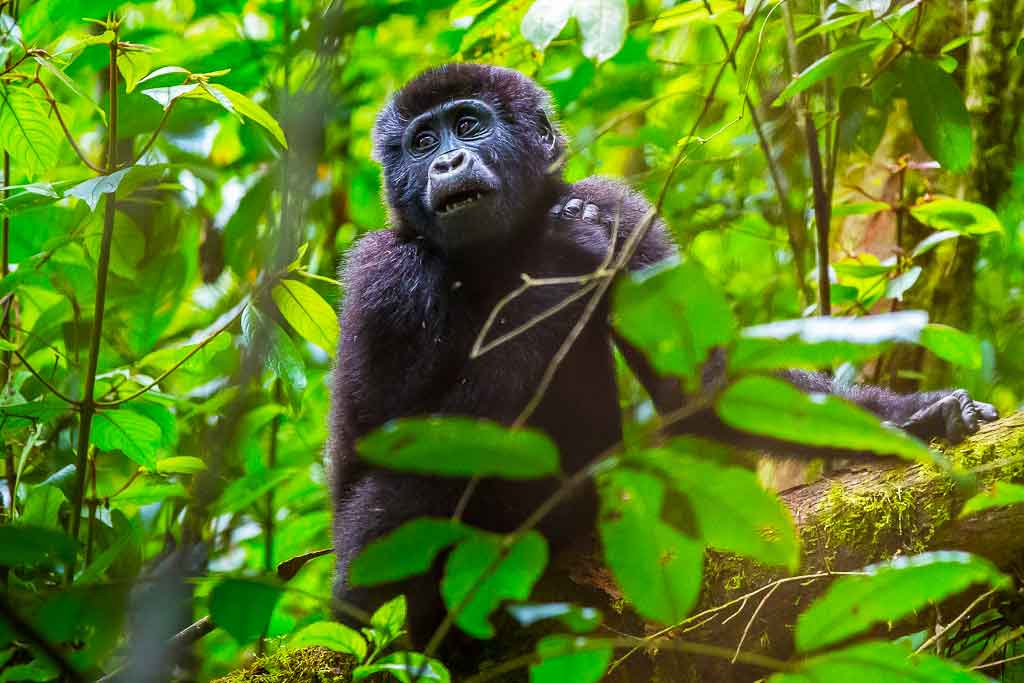
Need advice or you want to plan your safari?
We are here to help you!
Have questions or ready to start planning your Volcanoes gorilla tours? Fill out the form below and our team will get back to you with all the information you need.
We offer safaris and tours to.
Rwanda
-
Volcanoes National Park
-
Akagera National Park
-
Nyungwe Forest National Park
Uganda
-
Bwindi Impenetrable National Park
-
Queen Elizabeth National Park
-
Murchison Falls National Park
-
Kibale National Park
-
Kidepo Valley National Park
-
Mgahinga Gorilla National Park
-
Rwenzori Mountains National Park
-
Lake Mburo National Park
-
Semuliki National Park
-
Mount Elgon National Park
Kenya
-
Amboseli National Park
-
Tsavo East National Park
-
Tsavo West National Park
-
Nairobi National Park
-
Aberdare National Park
-
Meru National Park
-
Mount Kenya National Park
-
Hells Gate National Park
-
Sibiloi National Park
-
Ruma National Park
-
Saiwa Swamp National Park
-
Malindi Marine National Park
-
Watamu Marine National Park
-
Kisite-Mpunguti Marine National Park
-
Mombasa Marine National Park
Tanzania
-
Serengeti National Park
-
Ngorongoro Conservation Area (technically not a park but UNESCO-listed and managed like one)
-
Tarangire National Park
-
Lake Manyara National Park
-
Arusha National Park
-
Kilimanjaro National Park
-
Ruaha National Park
-
Mikumi National Park
-
Nyerere National Park (formerly part of Selous Game Reserve)
-
Katavi National Park
-
Mahale Mountains National Park
-
Gombe Stream National Park
-
Saadani National Park
-
Udzungwa Mountains National Park
-
Kitulo National Park
-
Burigi-Chato National Park
-
Rubondo Island National Park
-
Saanane Island National Park
Volcanoes gorilla tours and wildlife safaris.
The Great Wildebeest Migration
Over 1.5 million wildebeest, zebras, and gazelles move across the Serengeti and Maasai Mara in search of fresh grazing. This annual cycle includes dramatic river crossings and incredible predator-prey encounters.
Quality & Value Assurance
Our knowledgeable tour guides and dedicated customer care team give travelers peace of mind, ensuring that every plan made with us meets expectations. The prices we charge are a true reflection of the outstanding quality of our tours and the memorable experiences we provide. We pride ourselves on full transparency—there are no hidden fees, and our clear refund policy guarantees fairness. Confident in the excellence of our trips, we assure you of an unmatched travel experience, with a straightforward cash-back policy should you be unsatisfied. When considering our unique safaris, well-designed itineraries, breathtaking destinations, small-group adventures, and highly skilled guides, Volcanoes Gorilla Tours offers the best value for your safari investment.
Africa Wildlife Safaris
Africa wildlife safaris offer unforgettable adventures across some of the continent’s most iconic destinations, including Uganda’s Bwindi Impenetrable National Park and Queen Elizabeth National Park, Kenya’s Maasai Mara National Reserve and Amboseli National Park, Rwanda’s Volcanoes National Park and Akagera National Park, and Tanzania’s Serengeti National Park and Ngorongoro Crater. From thrilling gorilla trekking in the misty forests of Uganda and Rwanda to witnessing the Great Migration in Kenya and Tanzania, these safaris provide breathtaking encounters with Africa’s diverse wildlife, stunning landscapes, and rich cultures.
Rwanda
- Classic Rwanda Primate Safari (4–5 days: Volcanoes National Park gorilla trekking + Kigali)
- Grand Rwanda Primate Safari (6 days: gorillas + golden monkeys in Volcanoes NP)
- Classic Uganda & Rwanda Gorilla Safari (8 days: Rwanda + Bwindi Uganda)
- Epic Uganda & Rwanda Primate Safari (15 days multi-country)
- A Touch of Rwanda Gorilla Safari (4 days)
- Rwanda primate trek plus cultural extension in Kigali
- Volcanoes NP gorillas + Akagera park wildlife circuit
- Gorilla trekking plus Dian Fossey memorial and community visits
- Four-day Volcanoes base: twin gorilla visits, golden monkeys, nature walks
- Rwanda wellness + primate safari combining gorilla tracking with high-end eco-lodges
Uganda
- Uganda Gorilla Trekking Safari (Bwindi Impenetrable NP, 3 days)
- 10-Day Primates of the Rift Valley Safari (Kibale, Mgahinga, Queen Elizabeth)
- 6-Day Uganda Wildlife & Gorilla Safari (Murchison Falls + Bwindi + Queen Elizabeth)
- 8-Day Wildlife Tour & Gorilla Trekking (Kibale, Queen Elizabeth, Bwindi, Lake Mburo)
- 12-Day Uganda Safari & White Water Rafting (Murchison + Kibale + rafting + gorillas)
- 2-Day Murchison Falls Safari with boat cruise
- 2-Day Queen Elizabeth NP Wildlife Safari & boat cruise
- 2-Day Lake Mburo Safari near Kampala
- Kidepo Valley Remote Wildlife Safari & Exclusive Wildlife Experience
- Semliki Reserve Savannah-Forest‐Lake Safari
Kenya
- Classic Safari: Masai Mara – Amboseli – Nairobi
- Masai Mara Great Migration safari (3–5 days)
- Kenya & Tanzania Migration Combo (Serengeti + Masai Mara, ca. 10 days)
- Amboseli & Tsavo Explorer Tour
- Aberdare + Nakuru + Naivasha + Masai Mara circuit
- Nairobi-based tour: Sheldrick Wildlife Trust, Giraffe Centre, Masai Culture + Mara drive
- Tsavo West & East safari with Mzima Springs & wildlife hides
- Samburu + Shaba + Buffalo Springs arid‐north wildlife trail
- Hell’s Gate day-trip + Naivasha Lake cruise + Amboseli circuit
- Luxury Angama Mara + Kimana Amboseli private safari experience
Tanzania
- 7–10-Day Serengeti + Ngorongoro Crater classic safari
- Migration Safari: Serengeti + Maasai Mara cycle (East Africa combo)
- 10-Day Kenya & Tanzania tour with Serengeti and Zanzibar extension
- Serengeti phototour + balloon + crater rim stays
- Ngorongoro Conservation Area wildlife & Olduvai Gorge heritage loop
- Tarangire + Lake Manyara + Ngorongoro safari circuit
- Ngorongoro + Serengeti + Lake Eyasi cultural/baobab visits
- Northern circuit expedition including Ngorongoro, Serengeti, Tarangire
- Southern safari trail: Ruaha & Selous Wildlife Reserve off the beaten path
- Cultural safari mixing wildlife with Maasai and Hadzabe tribe encounters
Contact us to give your vacation a new look.
Featured Headlines


